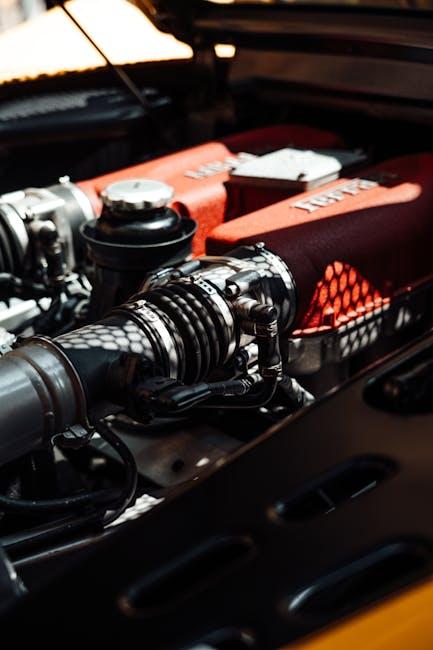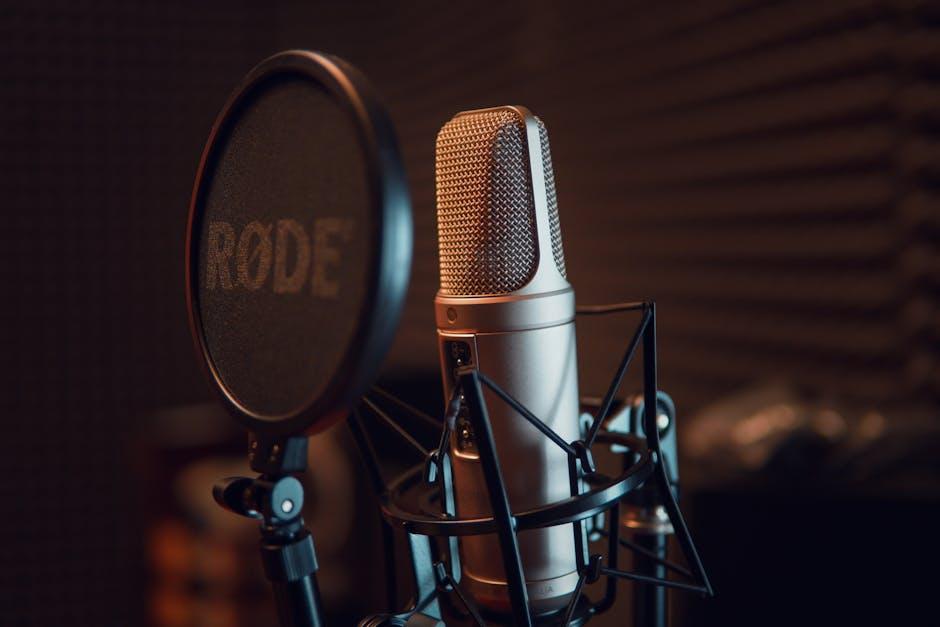Beneath the roar of a running engine lies the symphony of motion, power, and precision. Yet, for many drivers and mechanics alike, the clatter and drone can become an unwanted distraction, overshadowing the smooth hum that defines an ideal drive. Reducing engine noise is more than just a quest for quiet—it’s a journey toward enhancing comfort, protecting hearing, and preserving the longevity of your vehicle. In this article, we explore practical strategies and innovative techniques to tame the tumult beneath the hood, helping you rediscover the calm within your machine’s mighty heart.
Table of Contents
- Understanding the Root Causes of Engine Noise
- Choosing the Right Engine Oil for Quieter Performance
- Installing Effective Soundproofing Materials in the Engine Bay
- Regular Maintenance Practices to Minimize Noise Levels
- Upgrading Exhaust Systems to Reduce Engine Sound
- Exploring Advanced Technologies for Noise Reduction
- Q&A
- Insights and Conclusions

Understanding the Root Causes of Engine Noise
Engine noise often originates from multiple sources that intertwine to create the familiar mechanical roar or rattle. Worn-out components such as bearings, pistons, and valves can produce knocking or tapping sounds that signal internal friction or misalignment. Additionally, incomplete combustion can result in backfiring or pinging noises, which not only disrupt the engine’s harmony but can also hint at fuel or timing irregularities. Understanding these subtle audio cues helps pinpoint the malfunctioning parts and guides the right maintenance approach.
External elements play a significant role as well. Issues like loose belts, deteriorated exhaust systems, or unbalanced pulleys amplify vibrations and creaks, escalating engine noise levels unexpectedly. Below is a quick reference table highlighting common engine noise causes and their typical audio characteristics:
| Cause | Typical Sound | Possible Origin |
|---|---|---|
| Worn Bearings | Grinding or rumbling | Crankshaft and wheel areas |
| Loose Belts | Squealing or chirping | Accessory drive system |
| Exhaust Leak | Hissing or tapping | Manifold or muffler joints |
| Valve Issues | Tapping or clicking | Valve train components |

Choosing the Right Engine Oil for Quieter Performance
Selecting the ideal engine oil goes beyond just following the manufacturer’s recommendations; it’s about finding a lubricant that smoothly cushions engine components and minimizes friction. Thicker oils, often labeled as high-viscosity or synthetic blends, create a stronger protective layer that can significantly lower the clatter of metal parts rubbing against each other. Meanwhile, fully synthetic oils offer superior flow characteristics, especially in extreme temperatures, reducing the strain on your engine and promoting a hushed ride.
When evaluating engine oils, consider these essential factors to maximize noise reduction benefits:
- Viscosity Grade: Choose oils with viscosity tailored for your climate and driving habits — this controls how the oil flows and cushions.
- Additive Packages: Oils infused with anti-wear additives and friction modifiers enhance smoothness inside the engine.
- Synthetic vs Conventional: Synthetic oils often offer better mechanical noise dampening through improved consistency and thermal stability.
| Type of Oil | Noise Reduction | Temperature Range | Price |
|---|---|---|---|
| Conventional | Moderate | Standard | $ |
| Synthetic Blend | Good | Wide | $$ |
| Full Synthetic | Excellent | Extreme | $$$ |

Installing Effective Soundproofing Materials in the Engine Bay
When it comes to dampening the incessant hum from your engine bay, choosing the right materials is crucial. Butyl-based mats are a popular option thanks to their flexibility and robust noise reduction properties. These mats can be easily cut to fit into crevices and irregular spaces around the engine compartment. Another excellent choice is mass-loaded vinyl (MLV), which adds significant weight and density without the bulk, effectively blocking sound waves. Remember to pair these with heat-resistant foam layers to prevent any thermal damage, enhancing both safety and soundproofing efficiency.
Installation requires a meticulous approach to ensure maximum coverage without obstructing engine functions. Here’s a quick checklist:
- Clean the engine bay surfaces thoroughly before application to ensure adhesion.
- Measure and cut your materials precisely, avoiding excess overlap that may trap heat.
- Use high-temperature adhesive sprays or automotive-grade double-sided tape for secure mounting.
- Keep drainage and ventilation paths clear to prevent moisture buildup and overheating.
Below is a succinct comparison of commonly used soundproofing materials for engine bays:
| Material | Noise Reduction | Heat Resistance | Ease of Installation |
|---|---|---|---|
| Butyl Mat | High | Moderate | Easy |
| Mass-Loaded Vinyl | Very High | High | Moderate |
| Heat-Resistant Foam | Moderate | Very High | Easy |

Regular Maintenance Practices to Minimize Noise Levels
Regular upkeep of your engine plays a crucial role in keeping unwanted noise at bay and ensuring smooth operation. Start by consistently checking and replacing worn-out engine mounts and exhaust components, as these parts directly influence vibration and sound levels. Lubricating moving parts such as belts, pulleys, and bearings prevents friction-related noise. Don’t overlook the importance of changing engine oil and air filters on schedule; clean, high-quality fluids and efficient airflow reduce strain, making the engine run quieter and cooler.
Implementing a simple routine that includes periodic inspections can help identify noise-causing issues before they escalate. Below is a quick reference table for essential maintenance tasks linked to noise reduction:
| Maintenance Task | Noise Reduction Benefit | Frequency |
|---|---|---|
| Engine Mount Inspection | Reduces vibration noise | Every 12 months |
| Oil & Filter Change | Minimizes friction sounds | Every 5,000 miles |
| Exhaust System Check | Prevents rattles and leaks | Annually |
| Air Filter Replacement | Optimizes airflow, cuts noise | Every 15,000 miles |
- Routine inspections ensure early detection of abnormal sounds.
- Proper lubrication keeps parts moving smoothly without clatter.
- Timely replacements restore engine integrity and soundproofing.

Upgrading Exhaust Systems to Reduce Engine Sound
One of the most effective ways to curb unwanted engine noise is by upgrading your vehicle’s exhaust system. This isn’t just about swapping parts; it’s about optimizing sound flow and absorption. Modern exhaust upgrades incorporate advanced mufflers and resonators designed specifically to dampen harsh engine reverberations while maintaining performance efficiency. By selecting components with sound-canceling technology, you can significantly reduce noise pollution without sacrificing horsepower or fuel economy.
When considering an upgrade, focus on these key elements:
- High-flow mufflers with sound-absorbing materials to minimize exhaust roar.
- Resonators tailored to cancel specific engine frequencies.
- Quality piping that reduces vibrations and smooths airflow.
| Component | Function | Noise Reduction Level |
|---|---|---|
| Performance Muffler | Dampens sound waves, enhances airflow | High |
| Resonator | Targets and cancels specific noise frequencies | Medium |
| Exhaust Piping | Reduces vibration and smooths exhaust flow | Low to Medium |

Exploring Advanced Technologies for Noise Reduction
Modern advancements in noise reduction technology have revolutionized how engine noise is managed, blending engineering precision with innovative materials. Active noise control (ANC) systems use sophisticated microphones and speakers to produce anti-noise waves that effectively cancel out engine sounds in real-time. Meanwhile, smart acoustic liners, which are specially designed sound-absorbing panels, adapt their density and texture based on engine frequency patterns, drastically reducing reverberations inside the engine bay.
Additionally, emerging technologies harness the power of nanomaterials for insulation purposes. These ultralight, high-performance materials not only minimize noise transmission but also contribute to overall vehicle weight reduction, enhancing fuel efficiency. Below is a comparison table showcasing some key noise reduction technologies and their impact on engine noise levels:
| Technology | Noise Reduction (dB) | Additional Benefit |
|---|---|---|
| Active Noise Control | 12-18 | Real-time adaptability |
| Smart Acoustic Liners | 10-15 | Frequency-specific absorption |
| Nanomaterial Insulation | 8-12 | Weight reduction |
Q&A
Q&A: How to Reduce Engine Noise
Q1: Why is engine noise something I should care about?
A1: Engine noise isn’t just a minor annoyance—it can reflect underlying mechanical issues, affect your driving comfort, and even contribute to noise pollution. Reducing it can lead to a smoother, more enjoyable ride and potentially extend your engine’s lifespan.
Q2: What are common sources of engine noise?
A2: Engine noise can come from several places: exhaust gases escaping through leaks, worn or loose engine components, faulty bearings, inadequate lubrication, or even the engine’s own combustion process. Identifying the source is key to effective noise reduction.
Q3: How can I diagnose the cause of engine noise?
A3: Start by listening carefully: is the noise a ticking, knocking, or whining sound? Check for visible signs like oil leaks or loose parts. A professional mechanic’s diagnostic tools or a test drive might be necessary for tricky cases. Sometimes, a simple oil change or tightening a bolt can make a big difference.
Q4: What are some practical steps to reduce engine noise at home?
A4: Maintaining proper oil levels and quality helps the engine run smoothly and quietly. Tightening or replacing worn belts and mounts can reduce vibrations. Applying sound-deadening materials to the engine bay and ensuring exhaust system components are intact can also help silence the roar.
Q5: When should I seek professional help?
A5: If the noise is persistent, worsening, or accompanied by other symptoms like smoke, overheating, or performance drops, it’s time to visit a mechanic. Professional inspections can catch issues early and prevent costly repairs.
Q6: Are there upgrades or modifications to reduce engine noise more effectively?
A6: Yes—installing a high-quality aftermarket muffler, exhaust wraps, or sound insulation kits can significantly cut down noise levels. Some enthusiasts add harmonic balancers or upgraded engine mounts for smoother operation. Always balance noise reduction with performance and legal considerations.
Q7: Does regular maintenance impact engine noise?
A7: Absolutely. Routine oil changes, spark plug replacements, air filter cleaning, and scheduled tune-ups not only maintain engine health but keep noise to a minimum. Prevention is often the best noise control.
Q8: Can driving habits influence engine noise?
A8: Yes—aggressive acceleration and high RPM driving increase noise and stress on engine components. Smooth, steady driving helps the engine operate quietly and efficiently.
Q9: Will electric or hybrid vehicles solve the engine noise problem?
A9: Electric and hybrid vehicles produce less engine noise due to their electric motors and quieter combustion engines. If low noise levels are a priority, considering these technologies might be a future-proof solution.
Q10: What’s the bottom line for reducing engine noise?
A10: Understand the source, maintain your engine well, use quality parts, and adopt mindful driving habits. Whether you DIY or call in professionals, quieter engines lead to a more pleasant driving experience—and that’s music to any driver’s ears.
Insights and Conclusions
In the symphony of your vehicle’s performance, engine noise often plays a disruptive note. Yet, with thoughtful care and practical steps, you can transform that clamor into a quieter, smoother hum. Whether through regular maintenance, strategic upgrades, or soundproofing techniques, reducing engine noise not only enhances your driving experience but also prolongs the life of your engine. Embrace these methods, and let your journey be marked by calm and confidence—where the engine’s steady rhythm is a welcome companion, not a constant distraction.

